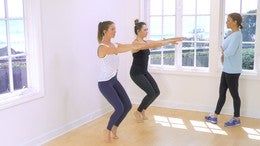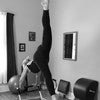Description
About This Video
Transcript
Read Full Transcript
We are here to do a little footwork on the reformer. Um, we are on two springs right now. Just light so that we can focus on how you're moving and not so much the weight of it. All right, so I'm having one of you in parallel and one of you turned out you're up on your toes and I want to make sure you've got all 10 toes on here, but the balls of the feet are on there for the support. Good. The thing we want to watch for is that you're not rolling your ankles out and that you've got even weight on the big toe, the ball of the foot and all the way down to the middle. So it's not easy to get, especially you want to keep more towards the big. All right, so let's just start with an extension.
You're going to go out and I want you to hold and just kind of notice what your feet do. Make sure you're not tensing them good and that your heels are up and you've got that weight on the yes, on the big toe and that you're not rolling out. And not so much the big toe, but the ball of the foot I should have said. And then you're going to bend and come in. So as you move, be conscious that you don't roll to those little toes or the big toe that you're on.
All of them and extend out and hold good. Double checking. Very nice. And come back in and do that two more times. Stretching out and also making sure you're not curling those toes up, that they're long and, and it's really interesting to watch feet and what people do, what we do. All of us. And one last one out and come in. Now let's go ahead and go to a parallel position for both of you.
And I'm going to bring you a little bit closer together and do good. And now, once again, you're going to go out, but this time you're going to hold the out. So go ahead and push out. And do you feel that at all in your ankles? Can you feel where the weight is? Can you, okay. Do you feel yourself rolling out? Okay. So that's what I want everyone to pay attention to is that when you go out and once you're out there is that you are rolling, that you fix that good and then you're going to come back in and then keep your knees a little bit apart and then stretch out a whole good. You want your ankles to be nice and straight, right on top of the metatarsal and in and one more time out.
And so if you have a weaker foot or if you've ever broken a foot or an ankle, what you can do is come back in his work on that one leg, one foot. So let's do that. So now even if you don't, they're good, they're great exercises. Keep the strength. We're going to drop you each to one spring. You're going to bring one leg into your chest and we're starting on the weaker one. You want to make sure all five of those toes are on the bar and your heels up as high as it's capable of going. And then you're gonna slowly, it's one springs very light stretch out. And then double check where that ankle is moving and that those toes are positioned properly and come back in and stretch out long wrap your hip so that you have that powerhouse control as you're moving.
And that will also help support you out was good. I found a foot that [inaudible] there you go and come back in and squeeze your seat. He what? Separated all the tenants? Units. Ankle. Yes. So she has had an injury on this side of, you can tell just by the way she moves this particular foot. So hopefully you at home can see that as well.
This right one, and come back in and stretch out.
And the last one, stretch. And in going back to your other foot, the one that was weaker, both of you, it's on your right. And then you're going to stretch out here in a hold. And then I want you to do a little tendon stretch. You're going to lower your heel lift and wrap your sigh, and then your knees and come in. So you're just gonna do one. He'll drop.
So you're going to push out and hold, double check your positioning, make sure you're not rolling out, feel it, not, don't look, feel it and lift. Or he'll bend your knee and come back in and you work on not straining to hold it. Push out, lower the heel, lift the heel bend and come in. You work on the knee and the hip staying turned out. Huh? That's it. And in and last one and stretch out.
Lower left. Good job with your toes and come back in and go back to the left. Just do three on the left. I'm gonna shift you a little bit lower left so that you're even doing a little less on the left than you did on your weaker side. Lower lift and, and, and last one out.
Lower lift and Kevin. And now you're going to stay and go back to both feet. I'm going to put you back on the two springs is now you've got two legs. We'll go ahead and give you a little more support and then you're going to go parallel. You're going to stretch out and you're going to hold and you're going to feel what's your ankles are doing had fix it and what your toes might be doing.
Make sure they're not straining to hold. And then you're going to lower your heels. Lift your heels, bend and Kevin, are you able to lower your feet a little so your toes are stay on the bar. When you lower your heels, push out lower. That's better lift. And in there you're going to stay out and just walk.
And I want you to hold one of the heels down and the other heel up and not move. And then find those hip positions so that your hips are down, but more. Yeah, and you follow this line from the ankle to the knee up to your hip and then switch and really lower the heel. Don't roll and switch. So straight down with the heel, that's it. And then straight up with the heel and straight down with the heel and straight up with the heel. And now walk. One, two, three, pool up, push down, make sure they bend. So pull up, say your toes. That's it, and lower and lift and stay on this and lower and lift and quickly.
Now, 10, nine, eight, don't rule seven, six, five, four, three, two, one and come in. So little exercises you can do standing or on the reformer, which will really help. Okay. You're all done. Very nice.
Comments
Her left leg was growing faster than her right leg. She will benefit from the single leg work. Thank you. P.S. because of her diligent work in Pilates she is able to run a 5k without pain.
You need to be a subscriber to post a comment.
Please Log In or Create an Account to start your free trial.
















